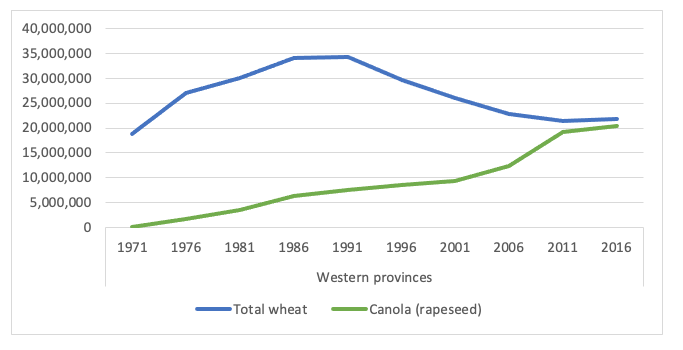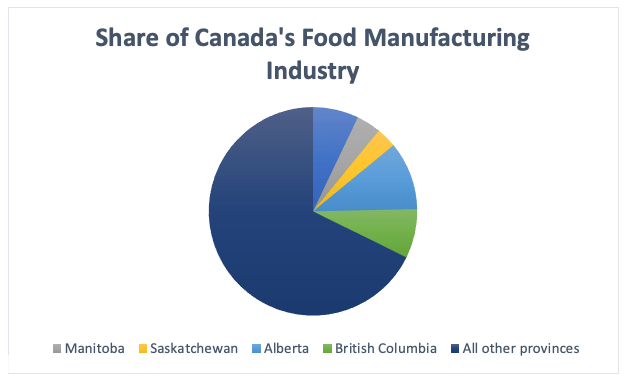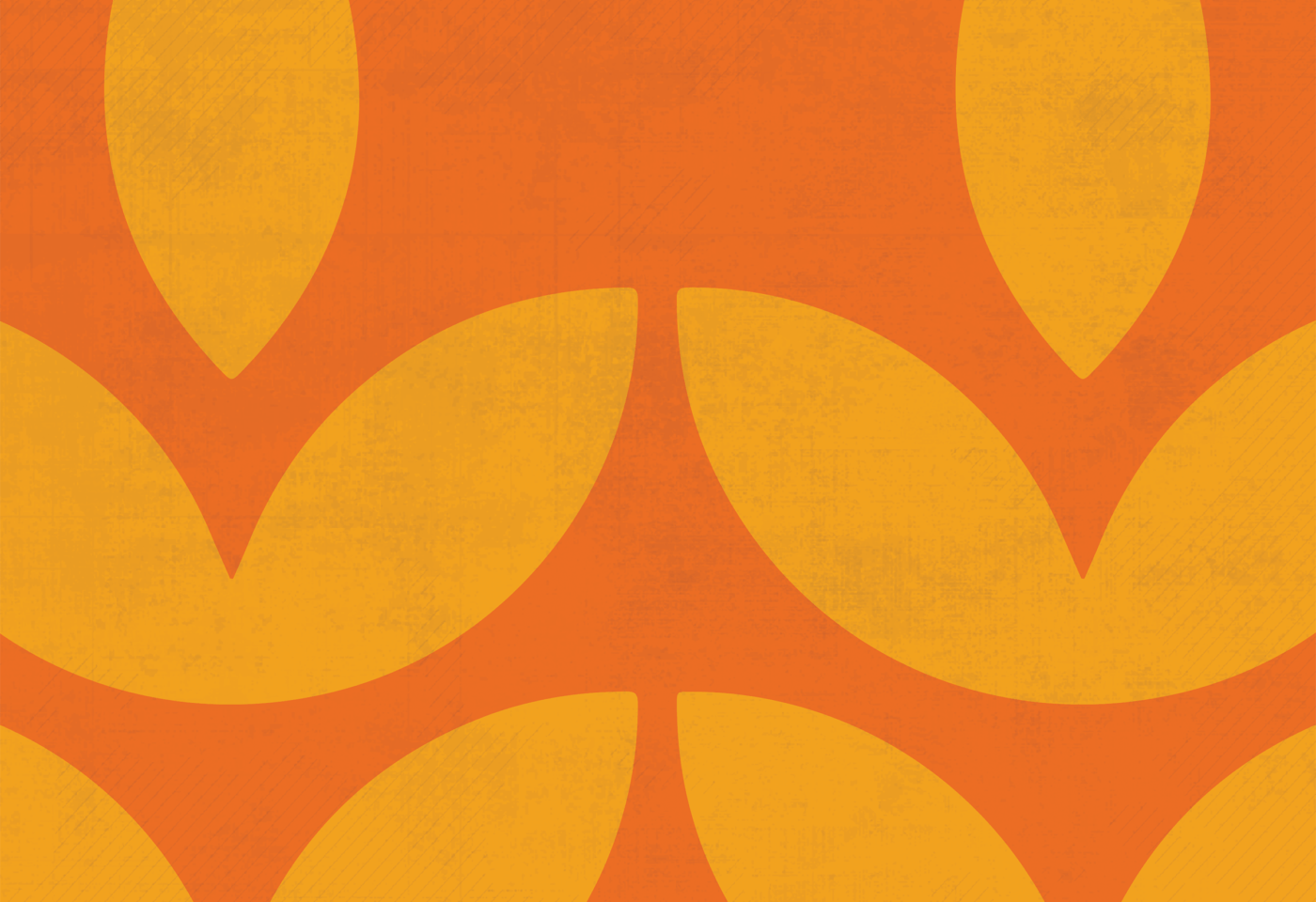AGRICULTURE AND AGRIFOODS
Agriculture and Agrifoods
By Marissa Dimmell
Grain policy overhauls in the 1990s and 2000s changed the rules of the grain farming game across the Western Canadian Prairies, triggering in turn a historic transformation of the landscape of Western Canadian agriculture. Decades after the removal of the Crow Rate in the 1993 and the abolishment the Canadian Wheat Board in 2012, Western Canada’s agricultural production has witnessed significant diversification in crops and changes in agricultural operations. And with more products seeking a way to more markets, Western Canada’s transportation network has also seen great change.
Further diversification, value-added processing and improving the movement of agricultural exports will drive future prosperity.
Grain Policy Overhauls: The Crow Rate and the Canadian Wheat Board
The Removal of the Crow Rate
For generations, the Crow Rate was a hallmark policy in the grain farming business — a constant that farmers depended on each year to subsidize the cost of transporting their wheat and barley crops to market. In 1897, the Canadian Pacific Railway asked the federal government for assistance extending its tracks over the Crowsnest Pass in Alberta — a request the government granted in part because of its ability to simultaneously appease the growing number of Prairie farmers disgruntled over high rail freight fees. The Crowsnest Pass Agreement was signed in 1897 between the Canadian Pacific Railway and the Government of Canada — later extended to include CN — to regulate freight rates on grain and flour moving from the Canadian prairies to eastern and western ports. Combined with the highly decentralized network of grain elevator delivery points and railway branch lines, the Crow Rate kept transportation rates low for farmers, so low in fact it at one time enabled farmers to send a bushel of grain 1,000 km for 15 cents — approximately the same cost as mailing a letter.
Although popular with farmers exporting grains, the subsidy created a clear market bias. Because of the subsidy guaranteed by the Crow Rate, wheat was preferred by farmers over alternative crops, even in years when it received lower prices than other crops. The freight subsidy also deterred using grain locally for cattle feed and processing — uses that were not included under the umbrella of the subsidy but offered higher returns as compared to pure wheat production. But importantly, the Crow Rate had established a status quo in rail transportation in Western Canada that discouraged investment in capacity to move more grain.
The railways lobbied for the removal of the Crow Rate to improve business revenues. Farmers, their organizations and Prairie provincial governments, on the other hand, pushed for its retention — arguing for its continuation as a national policy promise to prairie residents.
After years of inquiry and public opinion polling, the Crow Rate was discontinued permanently in 1993. Grain farmers were not cut off cold turkey — a one-time payment was provided through the Western Grain Transition Payment program. In the following year and moving forward, farmers had to pay twice, if not triple, the cost of their previous freight bills. The blow was softened in the following year when the price of wheat fell and the incentive to seed other crops became clear.
Years later however, many still lament the loss of the Crow Rate — nostalgic for the days of grain transportation and the low freight rates that characterized them. Yet, as explored in a later section, the removal of the Crow Rate — despite its blow to Prairie farmers — led to the diversification of Prairie agriculture.
The Abolishment of the Canadian Wheat Board
The removal of the Crow Rate was but one policy change grain farmers had to adjust to over the past few decades. The abolishment of the controversial Crown corporation — the Canadian Wheat Board — also represented a key turning point for grain policy in Western Canada.
Established in 1935 in Winnipeg, Manitoba, the Canadian Wheat Board (CWB) was Canada’s agricultural marketing board that, until 2012, was the sole buyer and seller of Prairie wheat and barley. The “single desk” model of the CWB made it illegal for farmers to sell their grain to anyone other than to them.
At the time of its establishment, the collective grain marketing approach of the CWB was attractive, mitigating the bargaining risks for farmers and giving them a stronger clout in world markets. But the CWB’s failure to respond to the changing needs of the market over time led to rising levels of discontent with the monopoly system. In 2012, Prime Minister Stephen Harper’s government replaced the CWB with a voluntary market organization, one that promoted a free-market approach to grain marketing. The CWB was sold in 2015 to G3 Global Grain Group.
The abolishment of the monopoly of the CWB was viewed by some as a day of liberation — a win in the battle for increased profitability and efficiency. Others viewed the removal of the institution as yet another blow to the average farmer, shifting the distribution of power away from small operators to giant multinational corporations that dominate the grain trade. But like the elimination of the Crow Rate, the effect has been to diversify both production and markets.
Eggs in Many Baskets: The Diversification of Prairie Agriculture
The grain policy changes of the 1990s and 2000s were contentious, but the removal of the Crow Rate and the abolishment of the CWB — the policies that shaped the grain farming industry — changed the industry and with it, how farmers across the West approached their agricultural operations.
Crop Diversification
Following the removal of the Crow Rate, the consequences of eliminating the subsidy that made wheat and barley the most affordable crops to transport became apparent, tipping the scales in favour of other, formerly less popular crops. While the effects of the removal of the Crow Rate were delayed due to record high wheat prices in the mid-1990s — prices that buffered the pain of the newly implemented changes— wheat acreage has witnessed a steady decline since the early 2000s, one that has been matched with increases in alternative crops including pulses, soybeans, potatoes, corn and importantly — oilseeds.
Between the 1996 and 2001 censuses—the first time the effects of the Crow Rate were quantified — wheat acreage across the Western provinces fell by 12.6%, a decline that has continued in the years since. While across the Prairies wheat continues to be king in terms of acreage, between the removal of the Crow Rate in 1993 and the most recent census in 2016, wheat acreage fell by 36.4% — shrinking from approximately 34.3 million acres in 1991 to roughly 21.8 million acres in 2016.[1]
Commensurate with the declining wheat acreage across the West, field peas and lentil acreage more than doubled in Manitoba, Saskatchewan and Alberta between 1996 and 2001 — growth that continues today with field peas acreage increasing from 490,290 acres in 1991 (Crow Rate era) to 4,229,584 acres in 2016. Between 1996 and 2001, potato acreage in the Western provinces increased by roughly 37%. Soybean crops also increased — from 921 acres reporting in 1991 to 1,893,554 acres in 2016. [2]
The largest crop increase following the removal of the Crow Rate was canola. As a newly introduced “made in Canada” crop, canola was already growing in acreage from the 1970s through the early 1990s. Yet after the removal of the Crow Rate in 1993, the rate of growth in canola acreage increased dramatically — from just over 7.5 million acres of canola in 1991 to roughly 20 million acres in 2016, growing at rate of 169% over the time period. [3]
Figure 1: Acreage of wheat and canola, Western Provinces, 1971 to 2016

Source: Statistics Canada
Livestock Diversification
The diversification spurred by the removal of the Crow Rate also translated into shifting patterns of livestock operations across the West.
In the years following the removal of the Crow Rate, Manitoba tripled the size of its hog industry — with over 3.3 million head, the province now accounts for 30% of the national hog industry. Growth has also been seen in cattle farming, with a 21.7% increase in number of cattle in the Western provinces between 1991 and 1996. Farmers also began branching out livestock operations to include bison, elk, llamas, and ostriches; between 1996 and 2001, the number of ranched bison doubled in the Western provinces. [4]
* Less than $500 worth of receipts is reported as 0.
Figure 2: Farm cash receipts percent of total, by product, Western provinces, 1971 and 2020

Source: Statistics Canada
Growth of Value-Added Agri-food Industry
Tremendous growth in value-added agri-food industries in the West was another opportunity for diversification spurred by the removal of the Crow Rate in 1993. Western Canada’s food processing sector grew by over $2.5 billion between 1993 and 1996 — or over 20% in those three years. Now, Western Canada has a large share of Canada’s meat processing, feed and vegetable oil production than the rest of Canada — home to pork, beef and canola, among other processing facilities — with Alberta and BC alone accounting for roughly 22% of Canada’s food processing industry in 2020. What’s more, as of 2020, the four western provinces were home to 27% of Canada’s food manufacturing industry.[5]
Figure 3: Share of Canada’s Food Manufacturing Industry, by province, 2020

Source: Statistics Canada
Getting on Track: Overhauls to Grain Transportation
The Crow Rate was key in triggering diversification of agriculture across the West; the abolishment of the Canadian Wheat Board, on the other hand, prompted a different, equally important change to the landscape of Western Canadian agriculture — overhauling the rail transportation infrastructure that brings farmers’ crops to market — the only option for Western Canadian bulk grain destined for global markets. Growth in grain exports over the past few years has been directly linked to rail capacity — success that has been driven by the investments made by farmers, railways, ports and shipping companies.
During its lifetime, the CWB was not only a monopoly buyer, but also a monopoly seller. In this capacity, the CWB was responsible for coordinating the logistics of getting the grain to market working in conjunction with the rail companies. Under their monopoly, the CWB imposed a limit on the volume of grain transported at any one time, keeping the volume of grain small enough that railways were not overextended. The abolishment of the CWB also removed this quota, opening Western Canada’s rail system to the ebbs and flows of a free market—testing in turn its ability to adapt to the rapidly changing grain supply chain in the West. The newest challenge to the system emerged–the “never-ending race between the ability of farmers to grow bigger and bigger crops and the ability of the grain-handling system to carry it all”.
A historic backlog of grain that occurred in the winter of 2013 showed just how challenging our logistics system is. The perfect storm of a record harvest in the West, one of the coldest winters on record and an overburdened rail system that failed to keep pace with the needs of the grain sector cost Western Canadian farmers CAD $5 billion in lost or deferred revenue.
The winter of 2013 highlighted the critical need to modernize the rail system in Western Canada to meet the needs of a supply chain that was adjusting to the end of the Wheat Board monopoly. While the federal government imposed minimum grain-hauling requirements for the railways between 2014 and 2016, the rail companies themselves took immediate action to overhaul the system. Record investments by the rail companies have been made in recent years, to update and expand the system’s infrastructure. Annual capacity investments by the major railways have tripled since the abolishment of the Canadian Wheat Board — growing from $1 billion annually in the early 2000s to more than $3 billion by 2014. The resulting agricultural carload shipments also increased from 412,099 to 465,340 over the same period. In 2019 Canada’s railways invested a record-breaking C$3.1 billion in new capital programs to support growth and service enhancements.
Infrastructure investments have also been made by the grain companies themselves. Viterra, Richardson International and Cargill — who collectively handle approximately 75% of Canada’s grain exports — have invested in significant new terminal capacity since the end of the Wheat Board monopoly in 2012. In all, 23 new investments –from grain elevators in Saskatchewan to major terminal upgrades in ports in Vancouver and Thunder Bay — have been made. Upwards of CAD $500 million in infrastructure investments have been made by Viterra and Richardson since 2012. G3 Global Grain Group — who acquired the CWB’s assets — has invested CAD $50 million in a terminal in Hamilton and two high-efficiency elevators in Saskatchewan and Manitoba.
Historic levels of investment in grain transportation networks have not, however, eliminated age old tensions between the needs of farmers and the delivery of seasonal products to market — which often hinge on peak pricing — and transport capacity limitations due to the physical limits of infrastructure and shipping companies. Compounding this — and tandem with the disappearance of the West’s iconic grain elevators — are trends in disappearing rail branch lines, forcing farmers to build their on-site storage and making transportation distances to bring grain to market that much longer. Despite this, progress is still being made, with Canada now selling more agricultural products than ever before.
Moving forward, while the rail system in Western Canada has seen a massive overhaul in recent years and the general logistics of the system work well, opportunities for improvement still exist. Read the Canada West Foundation’s A Smoother Track for Exports: A framework for Alberta rail policy for a complete analysis and a set of recommendations.
Read more:
CWF turns 50
Our West: People, Places and Progress from 1971 to 2021
Sources
[1] “Selected Crops, historical data,” Statistics Canada, Table: 32-10-0154-01.
[2] Statistics Canada, “Selected Crops.”
[3] Statistics Canada, “Selected Crops.”
[4] “Selected Livestock and Poultry, Historical Data,” Statistics Canada, March 13, 2018, https://www150.statcan.gc.ca/t1/tbl1/en/tv.action?pid=3210015501.
[5] Source: Canada West Foundation estimates based on Statistics Canada, “Gross Domestic Products at basic prices, by industry, by provinces and territories,” https://www150.statcan.gc.ca/t1/tbl1/en/tv.action?pid=3610040201.
